Vintage Ukulele Q & AUkulele History & Vintage Ukuleles:
Questions, Answers, and Information
Do you want to know more about a vintage ukulele that you own?
Do you want more information about a historic ukulele player or manufacturer?
Do you want to share historic ukulele information with us?
Ask our team of specialists a question. If you want information about a vintage ukulele, it really helps if we have pictures.
All questions will be answered via email, sent to the address you provide on the form or in your email. On this page, we will display some of the questions and answers. If you prefer not to have your question displayed publicly on this page, just let us know when you write us. Although this page is only updated occasionally, we answer questions by email on an regular ongoing basis.
Note that our area of expertise is American and Hawaiian made ukuleles from the 1950s or earlier.
Click Here for the 2007 Question Archive
Click
Here for the 2008 Question ArchiveClick Here for the 2009 Question ArchiveHere are questions that have been asked & answered. Click on any of the photos for a larger view.
Date: March 12, 2011
Question:
Please help with identifying this uke. It's a Serenader and is labeled as such (B & J). Any idea of age and actual maker?
Answer:
Your ukulele was made by Regal, one of the big Chicago-based ukulele manufacturers. It was most likely made in the 1930s. The scroll stencil, fretboard markers, and fretboard extension decal are all Regal characteristics.
|  | 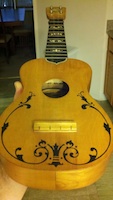
|

Date: March 6, 2011
Question:
I picked up this old ukulele at my mother's house (we used to live in Hawaii) which says "Hawaiian Ukulele" inside with a picture of a man playing a ukulele and at the bottom says "Especially made" for and then a series of letters. Can you help me to research this? Thank you!
Answer:
The letters B. L. & F. at the bottom of the label stand for Barth, Lutchen, and Feinberg, a major musical instrument distributor based out of New York city in the 1920s. They sold ukuleles made by various companies, putting their own labels inside (or having the manufacturer glue in the BL&F label). I know that BL&F sold some ukuleles made by Harmony, but yours does not appear to be a product of the Harmony factory. The last photo showing no heel cover or two-piece neck suggests that your ukulele was made on the mainland. It was made to look similar to a Hawaiian ukulele. It is probably from the early 1920s but could even be from the later teens. I am not sure about the specific manufacturer.
|  | 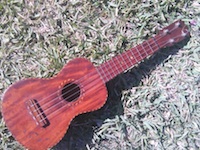
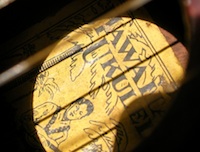
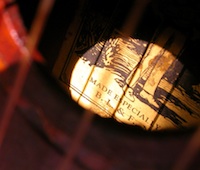
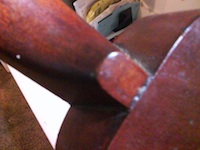
|

Date: March 6, 2011
Question:
I am trying to help a friend identify the maker and year of manufature of this instrument. I think it is an 8 string tenor ukulele. What are your thoughts? Thanks.
Answer:
That is a very interesting instrument, but I don't think it is related to the ukulele. It is a type of mandolin now often called a mandolinetto. These were popular in the first few decades of the 1900s. I have seen a pretty good number of mandolinettos over the years, but yours is very unusual. The carved headstock is especially unusual - I would think that it could be used to help identify the maker, but I have never seen it before. Any readers who might have any information feel free to write in.
|  | 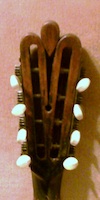
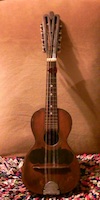
|

Date: March 6, 2011
Question:
Any info you can give me on the attached ukulele would be greatly appreciated. It's not in great condition. It was a crawl space find when we purchased our house in 1989.
Answer:
Your Banjo Ukulele is a Wendell Hall Professional model made by the Ludwig & Ludwig of Chicago, Illinois. Ludwig made very high quality banjo ukuleles in the late 1920s through around 1930. They are prized by banjo ukulele players still today.The Wendell Hall Professional model was actually Ludwig's most basic model - it sold for $25 in the 1920s. Yours is a little rough, but the condition doesn't look all that bad. Pretty nice crawl-space find!
|  | 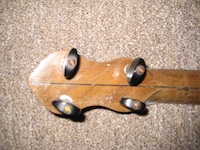
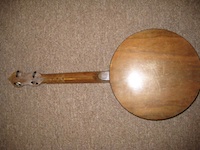


|

Date: March 6, 2011
Question:
Hi. I've just purchased this great uke and can't find information on it anywhere, I have found Aria and Ariana but not Arion...... It came in a case similar to a violin case and is in good condition. Regards.
Answer:
I don't know much about your ukulele except for the fact that it appears to be of German origin. The mark on the bottom reads "Ges Gesch". "Ges Gesch" is an abbreviation for "gesetzlich geschützt". Gesetzlich translates from German to English as "legally". Geschützt translates from German to English as "protected". From what I have read this mark was used on many German items much like a patent or trademark.
I am not familiar with the Arion name in particular or German ukulele manufacturers in general. I do know that the German company Bruko has made ukuleles on and off since the 1930s. But I have know idea if your ukulele has any relation to the Bruko company.
|  | 


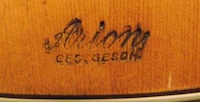
|

Date: February 25, 2011
Question:
I cannot find any information on SS Maxwell Ukuleles. Any information would be appreciated. Thanks!
Answer:
SS Maxwell was a trademark name of Targ and Dinner, a Chicago based musical instrument distributer. T&D bought instruments from various manufacturers and sold them under their own trade names. Your ukulele was made by a major Chicago manufacturer, Regal Musical Instruments. The SS Maxwell name was registered in 1931. I would estimate your ukulele was made sometime between the late 1940s and the middle 1950s based on the style of ukulele and the tuning pegs.
|  | 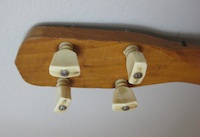
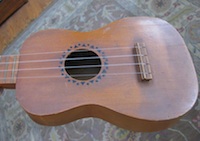
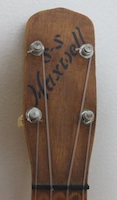

|

Date: February 23, 2011
Question:
I found this ukulele in a thrift store and I would like to know about how old it is. I have found other Kumalae ukes on the web but none with the same labels as this one. The one remaining peg is wooden. The inside label says "Ukulele O Hawaii made by Jonah Kumalae Honolulu especially for Sherman Clay and Co. San Francisco", with "Highest Award Panama Pacific Exposition 1915" around the outside of the label. It has a small crack, but the one string still sounds pretty good.... Any information you can give me would be great. Thanks.
Answer:
Your Kumalae decal is from his early period. I'd estimate your ukulele to be from 1916 - 1920. It is a pretty fancy model with the inlay on the body & fretboard. It is made from some very nice Hawaiian koa wood. It was model Kumalae designated as a model "D" Sherman Clay's model number was 24.
|  | 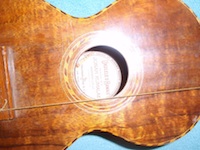
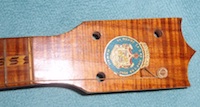

|

Date: February 23, 2011
Question:
Hello. I just purchased this Martin Concert Ukulele. I am unable to find photos of ones similar. The wood tuners are something i have not seen on the Concert size. Cheers.
Answer:
Your ukulele was made by the Regal Musical Instrument Company of Chicago, Illinois. The partial paper label is a piece of the standard Regal label. Winner was a brand name used by a particular instrument distributor, but I am not positive of which one. It was most likely the Manhattan Band Instrument Co. They registered a different "Winner" logo in 1926, so I would guess Winner was their brand name and that the logo just changed over the years. I would estimate that your ukulele was made between the late 1920s and the mid 1930s.
|  | 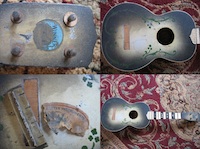
|

Date: February 23, 2011
Question:
Hello. I just purchased this Martin Concert Ukulele. I am unable to find photos of ones similar. The wood tuners are something i have not seen on the Concert size. Cheers.
Answer:
Your ukulele was made during World War II. The metal restrictions during the war forced Martin to use wooden pegs on many of their ukuleles, including some concert ukuleles. There were likely only a few hundred of these concert ukuleles made with wooden pegs, so they are not common. Looks like a nice ukulele - enjoy!
|  | 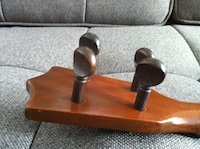
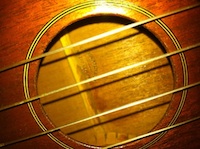

|

Date: February 23, 2011
Question:
I was wondering if you could tell me a little bit about a Washburn ukulele that I recently purchased from a widow. Her husband collected just about everything and brought this home about 40 years ago, but never played it. It's 21" long and has two patents - one pictured on the back of the headstock and one listed simply "PAT. APL FOR" on the bridge just below the saddle. I can't seem to find anything similar to this uke anywhere online. Thank you!
Answer:
Your ukulele was made by the Lyon and Healy Company of Chicago, probably around 1926-1928. The model number "5316" is stamped on the neck block. The 5316 was known as the "Collegian". It is made from figured mahogany. Lyon and Healy made very good quality instruments and the Washburn line were their best instruments. The 5316 was one of their more basic Washburn models, but it is still a nice quality instrument.
|  | 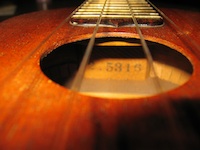
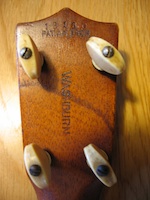


|

Date: February 23, 2011
Question:
Hi there. Congrats on a great web site! I have a couple of older Kumalae ukes and am interested to know more about the decal which has the following words in Hawaiian language:UA MAU KE EA O KA AINA I KA PONO. Do you happen to know what this means? The logo itself is very interesting with various figures and symbols on a shield flanked by two figures who appear to be standing on a stage with curtains drawn back by other figures. Is there any information on what the symbols mean or represent? Many thanks
Answer:
"UA MAU KE EA O KA AINA I KA PONO" is the Hawaii state motto. It's translation is "The Life of the Land is Perpetuated in Righteousness". The logo with the figures is a version of The Great Seal of the State of Hawaii. Obviously, the Kumalae ukuleles predate Hawaiian Statehood. At the time the ukuleles were made these were the Seal and Motto of the Territory of Hawaii.
|  | 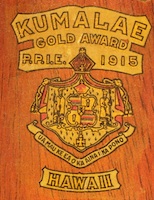
|

Date: February 23, 2011
Question:
We have a ukulele that my father purchased through a comic book during the 1920's. It has a material on it that looks like Ivory, but I don't think it is, it is very thin. It is located by the hole where it would be strumed and it goes up the throat under the strings. It is some type of wood with a white trim around it. The plastic tuning knob have screw in the top and the label inside is pretty much gone except for the letters "NL" and a number 10821 stamped on the throat and the inside of the instrument. I am more interested in the maker and history than the value, and it will stay in the family. Any information you can give me I will appreciate. Thank you in advance for your assistance in this.
Answer:
Your ukulele was made by the Harmony Company of Chicago, sometime in the 1930s. The label inside used to read "Supertone". Supertone was a brand name of the Sears Company. Sears actually owned Harmony at the time, and Harmony made many different musical instruments that were sold through Sears and elsewhere. The material on the fretboard is Pyralin - known to collectors today as "mother of toilet seat". Harmony made mostly inexpensive instruments, but yours is a better than average Harmony.
|  | 

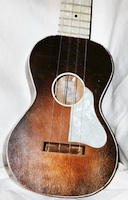
|

Date: February 23, 2011
Question:
I have inherited an old ukulele from my father-in-law. The only markings is the stamped logo, "Wings". It has wooden friction pegs rather than the newer tuning pegs. I cannot find any information on the manufacturer. Can you give me any information on this Ukelele?
Answer:
That is a great ukulele you have. I have a 1932 Carl Fischer catalog that includes this ukulele. It sold for $2.80 at the time. The description read as follows...
"Wings" - A low priced ukulele, handsomely finished and decorated. Ebony-black finish, with ivory, highlighting around the soundhole. Decorations on body, position markers on fretboard, and name stencilled in ivory. Semi-gloss lacquer finish.
These ukuleles were made by the Harmony Company of Chicago, Illinois. I don't know if the name has any relation to the 1927 movie Wings (the winner of the first Academy Award for best picture).
|  | 
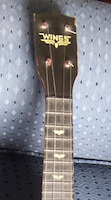

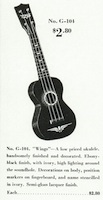
|

Date: February 23, 2011
Question:
I have this wonderful old instrument. Is there anything you can tell ma about it?
Answer:
B & J stands for Buegeliesen and Jacobson. B&J was an instrument distributor based in New York City. They did not manufacture their own instruments. Instead, they sold instruments made by an assortment of different companies. Their instruments were sold under a number of brand names, including Serenader, Mele, and SS Stewart. The Serenader name was first used on Ukuleles in 1926. The trademark was registered in 1927 and renewed in 1947, so it was used for quite a long period of time. Your ukulele was made by the Harmony Company of Chicago in the 1930s. It is one of Harmony's better ukuleles, with all mahogany construction. It appears to be in very nice condition.
|  | 
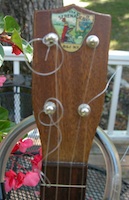
|

Date: February 23, 2011
Question:
Any idea age or make? No markings. Edges and hole has inlay. Bottom scroll work looks like glued rather than painted. At garage sale sellers only said was like a dept. store give-away uke. Back is just plain....thanks.
Answer:
Your ukulele was made by the Regal Musical Instrument Co. of Chicago Illinois. I would guess that it was made in the early 1930s. It has a spruce top. Regal made mostly inexpensive instruments. Your ukulele is actually somewhat fancy for Regal, with the colorful binding and the decal on top.
|  | 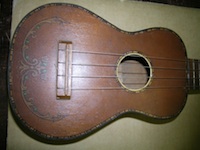
|

Date: February 23, 2011
Question:
I've got a ukulele from my father which he bought in the thirties while at sea with the trade mark AFSON. Can you say anything about it?Best regards.
Answer:
Afson was a brand name for the company A. Favilla & Sons. They made instruments in the later 1920s in New York. They are blood related to the more commonly seen Favilla Company, but they were a separate company run by another part of the family. Their instruments don't turn up a whole lot, they might not have been in business for too long.
|

Date: February 23, 2011
Question:
Found this at a yard sale I was gonna restore...I can't see it being a rare find...I'd like to know more about it...Would you know if this was made from mahogany or koa?
Answer:
Your ukulele's headstock decal used to read "Mele". "The Mele" was a brand name used by Buegeleisen and Jacobson (B&J), a New York City based musical instrument distributor. They sold many types of ukuleles that were made by a number of different manufacturers, and they used the name "The Mele" on a wide range of instruments from these manufacturers. Most of the instruments that B&J sold with the "The Mele" label were manufactured by the big Chicago companies like Harmony and Regal. I can't tell from your photos the shape of the bridge - this might be enough to know whether it is Harmony, a Regal, or something else. The wood does not look like koa to me, again it is hard to say for sure without bigger photos.
|  | 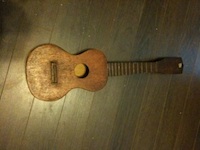
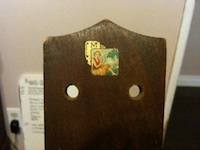
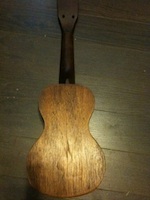
|

Date: February 23, 2011
Question:
Could you please identify the pictured ukulele and tell me about it.
Answer:
Your ukulele is a product of the Aloha Ukulele Manufacturing Company. The company was in business from 1917 to 1935 in Honolulu. The main ukulele builder there was Tai Chong Goo, who worked under the pseudonym Akai. The unusual headstock shape on your ukulele was used on many Aloha and Akai ukuleles, and I have never seen it used by another maker.
|  | 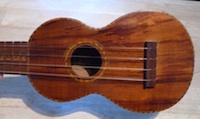
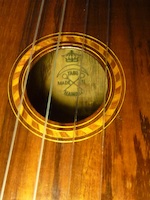
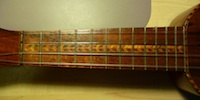
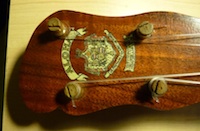
|

Date: February 23, 2011
Question:
I would like to know more about my uke which I'm told is a Lyon and Healy from the twenties. It's a simple teardrop model (with case) in great shape as near as I can tell and has "patent applied for" on the headstock. Thanks in advance for any info you can provide.
Answer:
Yes your ukulele was made by Lyon and Healy. It is a model they called "The Venetian". These were only made in the 1920s. I've attached an image of the patent, which was granted in June of 1928. By the time the patent was granted, Lyon and Healy had discontinued the manufacturing of all instruments (except harps). The Venetian was an inexpensive model, but they are still well-made and can sound pretty good.
|  | 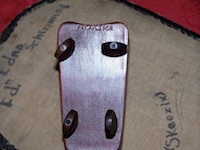
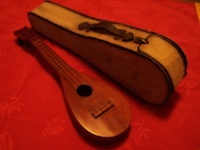
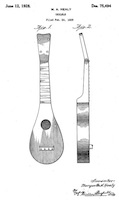
|

Date: February 23, 2011
Question:
Hello and thank you for this really great website! I hope you can help me pin a date on this oddball. It's a Roy Smeck uke with brass frets, the first i've ever seen (i own another Roy Smeck with a plastic fret board). Plastic tuners, looks to be solid mahogany and it's LOUD! my new favorite uke! :D
Answer:
The Harmony Roy Smeck ukuleles came in a few different iterations over the years. Your model, the soprano model with the painted wood fingerboard, was first sold in the first half of the 1950s, around 1954 I believe. In 1958 Harmony started using their plastic fingerboard on the Roy Smeck ukuleles. Harmony definitely sold a whole lot more of the plastic fingerboard model based on how often the different models turn up today. I too have one of the wood fretboard Smeck ukes - it is a nice little instrument.
|  | 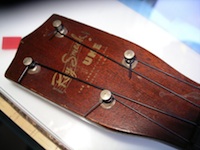
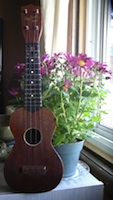
|

Date: February 23, 2011
Question:
Hi! I bought this old Martin Ukulele with its vintage gigbag. It can be open/close with two poppers on its back side. Can you tell me more about this instrument ? Many thanks for your help and cheers for all at the Museum!
Answer:
You have a beautiful looking Martin Style 1k soprano ukulele. It has a Hawaiian koa wood body. It was made between 1927 and the early 1930s. It appears from your photos to be in excellent condition. The case is probably original or at least from the same vintage as the ukulele. That type of case is notorious for damaging ukuleles - the snaps at the bottom sometimes will crack the bottom of the ukulele when popped shut. I'd suggest getting a decent hardshell case.
|  | 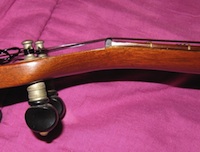
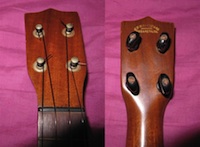
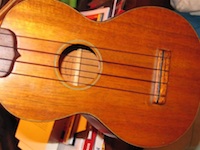
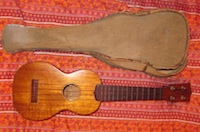
|

Date: February 22, 2011
Question:
Hello, Could you tell me about ukuleles that were manufactured in New York City? I was surprised to find out about a Brooklyn company in the 20s called Turturro's. Would you happen to have any more information about them or any other New York companies. Thank you.
Answer:
There have been a number of companies that manufactured ukuleles in New York City, primarily in the 1920s. Here is a short list...
Albert Houdlett & Son, Brooklyn: Made Nu-Way banjo ukuleles
Favilla, Manhattan, Brooklyn, later Long Island: Made ukuleles & banjo-ukuleles
Gretsch, Brooklyn: Made ukuleles & banjo ukuleles under many brand names
A. Mannello & Sons: Made Rivola brand ukuleles
Nicola Turturro: Made standard ukuleles, tiples, and unusual peanut ukuleles and the "turnover" a mandolin-ukulele combination
Epiphone (House of Stathopoulo), first Manhattan then Long Island City: Made banjo-ukuleles and some standard ukuleles
William Lange, Manhattan: Made banjo ukuleles
Sullivan & Ries, Brooklyn: Made banjo ukuleles
There were also a good number of distributors in NYC that would buy ukuleles from manufacturers and distribute them for retail trade. Sometimes paintings or decals were added by these companies to make the line their own. Some major NYC distributors include Buegeleisen & Jacobson (B & J), Progressive Musical Instrument Co. (P'mico), C. Bruno & Son, and the Henry Stadlmair Co. Just across the Hudson in Jersey City, NJ was Oscar Schmidt, a major musical instrument manufacturer that made many ukuleles and banjo ukuleles.
|

Date: February 22, 2011
Question:
Hello, I have this koa ukulele which I have been told is from the 1930's, it has the label inside but can't find any information about it. Could you please have a look and see if it rings any bells.Thanks you for your time.
Answer:
I believe your ukulele was made in California sometime between 1914 and 1920. As the ukulele became popular in California, a few different ukulele manufacturing plants opened in California. The ukuleles they produced were often made from koa, and they were sometimes patterned after Hawaiian instruments. The three piece neck on your ukulele is one of the features of many of these ukuleles - and it was pretty much unique to these California ukes. I think the California manufacturers all shut down as the larger Chicago instrument manufactures got going into ukulele production. Winship & Sons Music House was located in Spokane, WA (I am not sure if they had other branches).
|  | 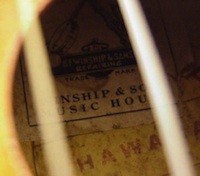
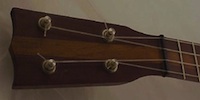

|
Date: February 22, 2011
Question:
Here are pictures of the Regal concert uke that I have owned for nearly sixty years. It was a used uke when I bought it. It was with me in the Korean War. The finish is beginning to crack. What can you tell me about this Regal uke? How old is it? What restoration methods are recommended?
Answer:
That's a great story about your ukulele. I think it is wonderful that you have held on to it for such a long time. I would estimate that your ukulele was made between the late 1920s and the late 1930s. Regal was a large Chicago-based instrument manufacturer. They made mostly inexpensive or mid-priced instruments, but some of their ukuleles play and sound great. If the cracking that you mention is just in the finish, I wouldn't be too concerned. If the wood itself is developing cracks, you should bring it to a good luthier who can handle the repair. I'm sure that you could get it refinished by a good luthier too, but I'm not sure that I see the need to do that.
|  | 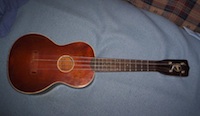
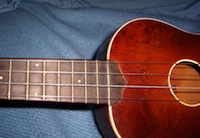
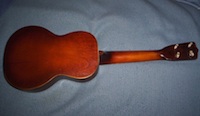
|

Date: February 22, 2011
Question:
I recently found this Ukulele and a \"sister\" Ukulele stored with other family items from the 50\'s. I did my research and beleived they were products of Jonah Kumalae, but not everything matched up. While reviewing all of your Q & A, and seeing several Kumalae, I\'m still not sure. The shape of the headstock and the chevron shape of the bottom of the neck neck suggest someone other than Kumalae. It has been suggested that they may have been made by Sam Chang or evey by Echo... Can you help. Since I have two nearly identical, this is refrenced as \"Y\' KE KE\" as it contains that name on the Headstock.
Answer:
Y'Ke'Ke was a trademark registered in 1926 by Jules M. Sahlien, a San Francisco based musical instrument distributor. He sold instruments made by a few different Hawaiian manufacturers. I am quite sure that both of your ukuleles were made by the Hawaiian Mahogany Company. This company was run by C.Q. Yee Hop & Co of Honolulu. They were selling "Royal Hawaiian" ukuleles by 1929 - possibly earlier. I would guess your ukuleles were both made in the late 1920s or early 1930s. Echo ukes were also a product of the Hawaiian Mahogany Company.Both of your ukuleles are high-end instruments, fancier than the vast majority of Royal Hawaiian ukuleles.
|  | 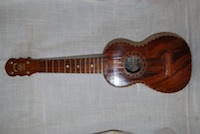
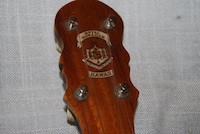
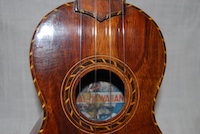
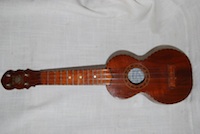
|

Date: February 22, 2011
Question:
I would be interested to know when this ukulele was made.
Answer:
Your ukulele, a Kumalae model E, is the high end of the Kumalae line. It was probably made sometime between 1920 and the early 1930s, but it would be difficult to be any more specific. It looks to be in very nice shape, except the bridge looks like a replacement.
|  | 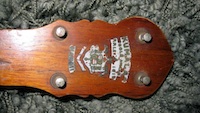
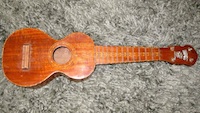
|

Date: February 22, 2011
Question:
Could you give me some info on my Ukulele?
Answer:
That is a great old Hawaiian ukulele you have. Paul Summers was a Hawaiian musician and music instructor in Honolulu, Hawaii in the 1920s and 1930s. He worked at both the Royal Hawaiian Hotel and the Moana hotel. He didn't manufacture his own instruments, he sold instruments made by a number of different Hawaiian ukulele makers. The Moana decal on your ukulele suggests to me that it may have been sold by Summers from a shop at the Moana hotel. The stamp on the back of the headstock is a stamp used by many Hawaiian makers to verify that there ukuleles were genuine products of Hawaii.Your ukulele is a very high-end Summers instrument. The beautiful koa wood, fancy inlays on the body and neck, and the fancy shape of the headstock are features that set your ukulele apart from the standard Hawaiian ukuleles of the time period.
|  | 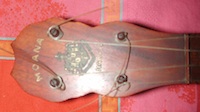
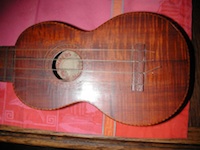
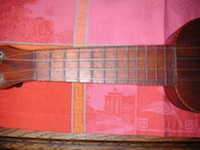
|

Date: February 22, 2011
Question:
Hi, I bought an old uke years back. It is called a Chickie. The label says made in Chicago. How old is it and do you know anything about its history?
Answer:
That's a great ukulele you have - very unusual. I have never seen another "Chickie" brand ukulele - I don't think a whole lot of them were sold. I am guessing that the TD on the label stands for "Targ and Dinner". Targ and Dinner was a large musical instrument distributor based in Chicago. They distributed instruments from many different manufacturers, so it is a bit harder to name a particular manufacturer. Chickie was likely a Targ and Dinner brand. The finish is what was referred to as a "Crystal" finish in its day. This type of finish was popular on inexpensive instruments in the 1930s. Also, it looks like a pretty nice hard-shell case it is in.
|  | 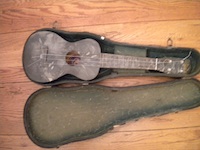
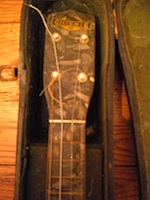
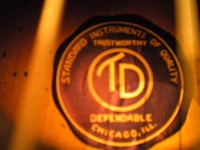
|

Date: February 22, 2011
Question:
I have already bought it but it hasn't been sent yet, but I would like to know this ukulele's information. I saw many website which have many information about martin ukulele, but I saw them example pictures, the standard martin koa ukuleles fingerboard are using rosewood or mahogany, so I think this one a little bit unusual, maybe you could help me more understand this ukulele. Thank you a lot :)
Answer:
That's a nice old Martin Style 2K you are getting. You are correct that it is an unusual model. This looks to be a very early style 2K. Martin first produced 2K ukuleles in 1919. Most were made for the Southern California Music Company, and were stamped on the back of the headstock with the Southern California Music Company stamp. So it is interesting to see such an early one with a Martin stamp on it. Another sign that it is a very early Martin is that the position markers are on the 5th, 7th, and 9th frets. The koa wood (?) fingerboard is definitely very early and unusual.
|  | 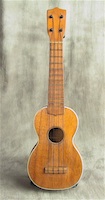
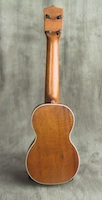
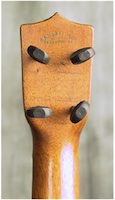
|

Date: February 22, 2011
Question:
The mystery uke is photographed above. It seems to be very well made. Grover tuners. Judging by the case, I'm assuming it's also late 40's, early 50s. There is no brand name on it anywhere that I can find. Any info would be greatly appreciated.
Answer:
Your "mystery" uke was made by the Harmony Company of Chicago, Illinois. It is likely from the 1920s, and it is made to look like a Hawaiian-made ukulele. I can't tell if it is Hawaiian koa wood or mahogany - I'd guess koa but it is hard to say for sure from your photos. This was a high-end ukulele for Harmony, with the fancy bindings and fretboard inlay. The tuning pegs are high end Grovers - they may be original or may have been replaced long ago.
|  | 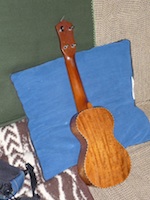
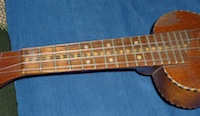
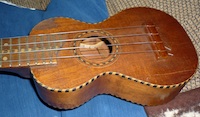
|

Date: February 22, 2011
Question:
Hello, I own a 1930's Martin 2K soprano Ukulele. It has the decal on the front and bar frets, it also has rosewood binding rather than the more common cream or white. Made in the USA is also stamped on the back of the peg head. I have been told that this means that it was for export, is this true? Many thanks.
Answer:
Your ukulele is actually a Style 1K not a Style 2K. As you mentioned, the 2K had ivory colored binding, while the 1K from that period had rosewood binding. I'd guess your ukulele is from the mid to later 1930s with its combination of features. It is true that the Made in USA stamp was used on instruments that were being exported.
|  | 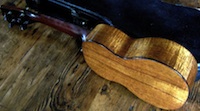
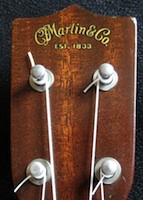
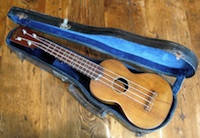
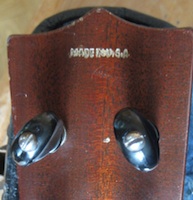
|

Date: February 22, 2011
Question:
Dear Ukulele Hall Of Fame Museum, Here is an all koa wood soprano ukulele made for the mainland department store, Rhodes Brothers (in Tacoma, Washington, established in 1892). Their label reads, "Rhodes Bros. / Incorporated / Hawaiian Ukulele Dealers / Tacoma, / Wash". I'm hoping you might be able to supply more information about this instrument's date of manufacture and possibly it's maker? The construction characteristics may give up some clues: it has a one piece koa wood rib and an arched back. It's a great player! Thank you for your website and this tremendous service!!
Answer:
That's a nice ukulele you have - I actually own a pretty similar one that I am guessing was made by the same company. Your ukulele has strong Hawaiian characteristics including the style of neck construction, the Hawaiian koa wood body, and the rope style binding. I think most people would tell you it is Hawaiian-made. Still, I believe your ukulele is actually an early mainland-made ukulele. As ukulele popularity grew in California in the teens, a few manufacturers went into business around California. Some of these California makers produced ukuleles very similar in style and construction to the true Hawaiian makers. I'm guessing your ukulele was made by one of the California manufacturers around 1914 - 1920. I assume the California manufacturers died out when Chicago companies started to mass-produce cheaper ukuleles.
|  | 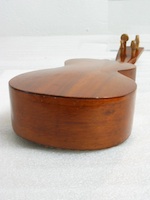
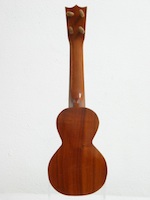
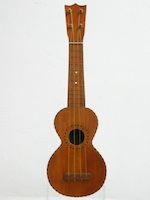
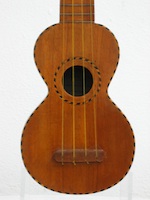
|

Date: February 22, 2011
Question:
New to the world of uke's, I'm a guitar player. I have been on the lookout for one for a while now. Bought this last week in a carboot sale in London and would love to find out more about it. Someone (over the phone) thought it was a Kumalae but didn't recognise the red shield lable. Any info highly appreciated. Thanks.
Answer:
Thanks for the photos. Your ukulele looks like an early Japanese-made ukulele to me. I can't say for sure it is Japanese, but I'm quite sure it was not made in the US or Hawaii. Definitely not a Kumalae (or other Hawaiian maker). I'd guess it was made in the late forties or early 1950s. I am not familiar with the headstock decal, but I guess it was applied by the London distributor that sold it. Sorry I don;t have more info.
|  | 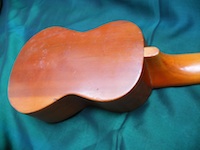
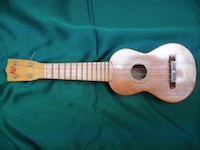
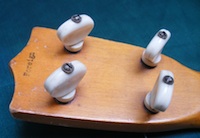
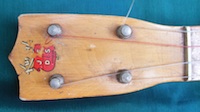
|

Date: February 22, 2011
Question:
Could your please help me idenify this Ukulele. I was a child when my uncle gave it to me. He was in Hawaii in the 40's. I would like to know as much about it as you can tell me. I have searched the internet and have not see another one like this. Thank You.
Answer:
That is a very interesting ukulele you have. This looks like a late 1930s or early 1940s Kamaka pineapple ukulele. The wood appears to be monkey pod not koa. The painting on the top is what makes it unusual. I have seen other styles of painting on Hawaiian ukuleles from this period, but never one quite like yours. I would guess these were hand-painted by someone and sold as souvenirs. The painting on your ukulele is nicely done and I think it is quite attractive.
|  | 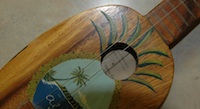
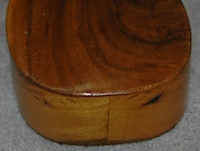


|

Date: February 22, 2011
Question:
This banjo uke was given to me because I am a banjo player. I haven't cleaned it up yet but am interested in what you can tell me about the instrument. I have never heard of the maker. The neck appears to be maple and is very solidly attached. Action excellent. It currently has metal strings (is this usual?) and is tuned to an open chord (like a 5-string banjo G tuning). Is this correct? Since I have not heard one of these things played, I am not sure what kind of music one might attempt (other than loud). Any pointers appreciated. PS: Great website!!
Answer:
The instrument in your photos is a banjo ukulele made by The House of Stathopoulo, know later as Epiphone. The company was run by Epi A. Stathopoulo. They made very good quality banjos, banjo mandolins, and banjo ukuleles. Banjo ukuleles were typically played (and strung) like standard ukuleles, but they were usually louder. Gut strings would have been the standard when this was made, today nylon strings are the standard. The standard ukulele tuning is GCEA (or sometimes ADF#B), with the G string tuned re-entrant (the strings don't go from highest to lowest pitch in order). George Formby is probably the best known banjo-ukulele player. You can check out his playing by doing a quick search on Youtube.
|  | 
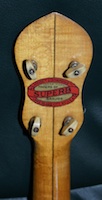


|

Date: February 22, 2011
Question:
Any information about this 8 string (soprano?) ukulele would be appreciated. It was my father's, who recently carved new pegs to replace missing ones. The interior label reads: manufactured by KOHALA CO. Hawaii. The soundhole is surrounded by white, red, green and black inlay. I am just starting to learn to play it. If I get the 2nd set of strings, how is it tuned, and do you need to buy a different type of string if notes are an octave apart? Thank you so much.
Answer:
Your eight string ukulele is known as a taropatch. Taropatches were popular from the later teens through around 1930. I would guess yours is from around the mid 1920s. It looks to be a product of the Regal Co. Regal was one of the big Chicago ukulele manufactures of the time. Regal was the only ukulele company that I know of that was using the multi-colored herringbone inlay, so I'm pretty sure they made your instrument. The Kohala label was probably added by the retailer. Hawaiian ukuleles had a better reputation than those made on the mainland, so many times deceiving labels like this were used to fool the potential buyer. It should be tuned as a standard ukulele GCEA, the pairs of strings are in unison - they are not an octave apart. So another set of standard strings is all you should need.
|  | 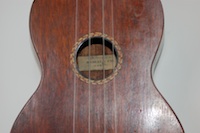



|

Date: February 22, 2011
Question:
I am trying to find out more info on a Ukulele I have. It was my aunt's and I now have it. She used it professionally and also played the piano. She was a character... (SMILE). Thank you for any information.
Answer:
Thanks for the photos. That is a great looking ukulele. I have seen an ad for the Band-o-uke but I have never before seen an existing example. The Band-o-uke was a product of the Oscar Schmidt Company of Jersey City, NJ. I am posting an Ad from May of 1928 with a picture of the Band-o-uke. I am guessing that Schmidt did not make a whole lot of these, as I have never seen another. By May of 1928 the ukulele craze of the 1920s was dying out and I am guessing these were not made for long. Oscar Schmidt made mostly inexpensive beginners instruments - but your Band-o-uke looks to be a better quality instrument than the typical Schmidt product. It is a great little instrument you have have.
|  | 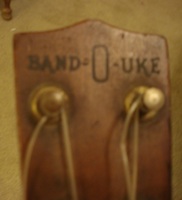
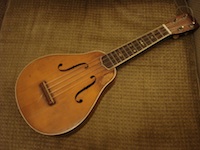
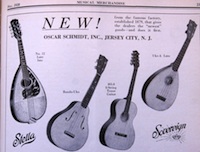
|

Date: February 22, 2011
Question:
Hi,I was wondering if you could identify this ukulele for me, and give me an idea of its quality/age. The only thing it says is "Handmade Leonora" on the inside. A friend of mine said it looked like a 1920's Martin by the style. It plays wonderfully: it has a really rich sound. This strings in the photos are not original; I switched them out, but I still have the original strings and they are in fine shape. I inherited it from my great aunt. Thanks.
Answer:
Your ukulele was made by The Rutan company of Kansas City, Mo. The company was named for the owner, John Rutan, who went into the ukulele business in 1926 (after being a partner running a retail music store). Their factory was eventually destroyed by a fire, I believe in the 1930s but I'm not exactly sure on that. Rutan made very nice quality instruments - very much in the style of Martin instruments. I would guess they patterned their instruments directly after Martins. While other manufacturers sometimes claimed to be as good as a Martin - Rutan ukuleles actually came quite close. Your ukulele is patterned after a Martin Style 2. It is all mahogany and appears to be in great condition (except for a possible crack on the side). I don't know anything about the "Leonora" name in the soundhole. It was likely a name used by a particular instrument retailer - but I do not know which one.
|  | 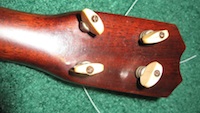
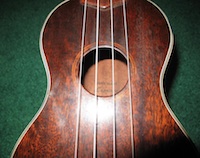


|

Date: February 22, 2011
Question:
Hello Ukulele Hall of Fame Museum,I was wondering if you might be able to help me identify this ukulele.I bought this ukulele off of Ebay a few months ago. The tuners and nut are not original. It has 16 frets total. She has white binding with a black stripe wrapped around the neck, front, back, and sound hole. The binding is also used for the bridge. The ukulele is solid mahogany. There are mother of pearl fret markers on the 3rd, 5th, 7th, and 10th frets. She is slightly smaller in the body than a normal soprano ukulele. While small she has a very loud, bright tone and is a fantastic player! There are no maker marks anywhere on the ukulele.Thanks in advance for the help.
Answer:
Your ukulele looks to me to be a model made by the JR Stewart Company. The beveled headstock, fretboard binding, and bridge shape all match with the style of ukuleles Stewart was making in Chicago in the late 1920s. It is also possible that it was made by Regal. A little background...JR Stewart worked for the Harmony Co. in the early 1920s before opening his own business making fretted instruments. The Stewart Company grew quickly in the second half of the 1920s. Their Le Domino line of instruments was quite popular and the company expanded rapidly. When Lyon & Healy stopped manufacturing their own fretted instruments in 1928, Stewart was chosen to manufacture the Lyon and Healy Washburn line of instruments. The Stewart company's rapid growth apparently led to its downfall. Less than six months after the stock market crash of 1929, JR Stewart declared bankruptcy. The Stewart trade names were sold to another Chicago Co., Tonk Brothers, who in turn sold them to Regal. Regal began making instruments nearly identical to the ones Stewart had been producing, including the Le Domino line. That is why it is difficult to say whether your ukulele is a Stewart or a Regal. Either way, it was likely made between 1925 and the early 1930s.
|  | 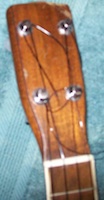


|
 |



























































































































































